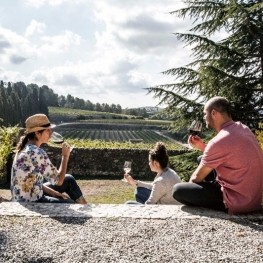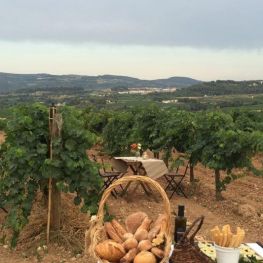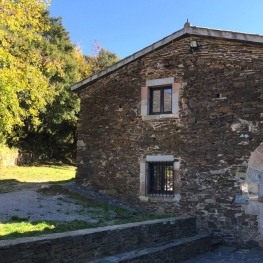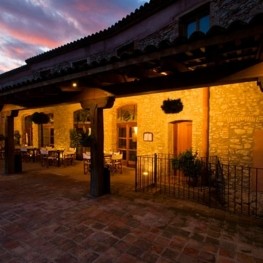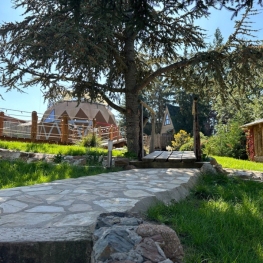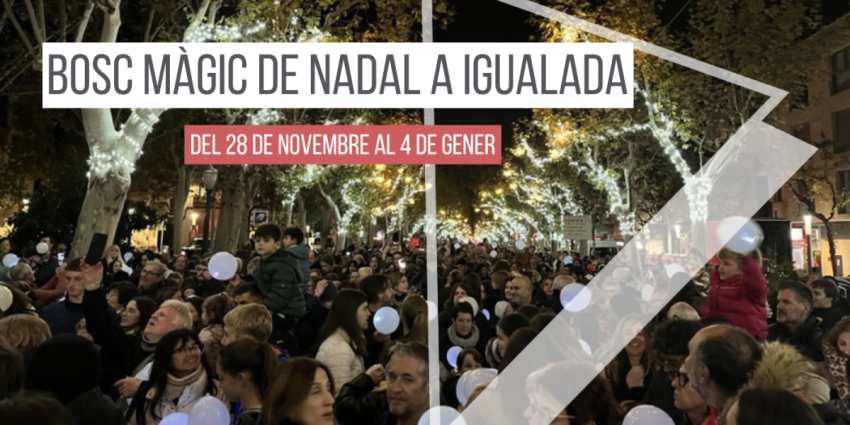Monumental trees of Catalonia

The monumental trees of Catalonia are those that are preserved and protected due to their particularity and species, thanks to a decree approved in 1987.
Since then, more than two hundred and seventy trees scattered throughout the territory have been declared, but the first to benefit from this protection were the Pi de les tres branques ( Berguedà ) and the Can Codorniu oak ( Alt Penedès ).
Each of the cataloged trees are distinct and different, in many aspects, and have their own history as monuments that are considered and are part of popular traditions. For this reason, the fact of preserving them goes beyond protecting them physically but also contributes to keeping alive some stories, some words, some moments...
 Some are close to a path, others in the middle of a meadow or even form part of a square. However, the number of trees located in rural areas stands out.
Some are close to a path, others in the middle of a meadow or even form part of a square. However, the number of trees located in rural areas stands out.
The declared monumental trees are marked with an information sign and can be public or private property.
Below we have collected a sample of some of the most characteristic and emblematic trees of our country -because of their majesty or beauty, because of what they symbolize, because of their location...- and which form part of the natural and cultural heritage of Catalonia.
Route's villages
The distribution by the territory
Currently more than two hundred trees have been declared in Catalonia as a whole.
Forests with white pine species are the most predominant, in terms of hectares, in our territory. However, when it comes to the existing tree with the largest number of specimens, this is the oak. Both species are the majority at low altitudes. On the contrary, at high altitudes, red pine forests tend to be the majority.
 Despite this predominance of certain species, there are many others. Well, among the two hundred trees cataloged as monuments there are more than 50 different species, where white pines, holm oaks, oaks, banana trees or stone pine predominate, among others.
Despite this predominance of certain species, there are many others. Well, among the two hundred trees cataloged as monuments there are more than 50 different species, where white pines, holm oaks, oaks, banana trees or stone pine predominate, among others.
These trees cataloged as monuments are relevant, especially, in the region of Osona while, for example, Gironès, Baix Penedès, Segrià or La Segarra are the regions that have fewer trees declared monuments, presumably because the density of forests is low and crops predominate.
For the same reason, in Osona, specifically in Espinelves, is the estate with the highest concentration of monumental trees in Catalonia. This is the Masjoan estate, a grove made up of a large number of tree plantations, many of which exceed 40 meters in height. It stands out in the Masjoan estate, especially, the Chestnut of India and the Maple.
The region that follows Osona in terms of number of cataloged trees is La Selva. This region is one of those with the largest extension of forests in Catalonia.
Also noteworthy as counties with a significant number of monumental trees are Pallars Sobirà, Alt Empordà, Vallès Oriental and Terra Alta.
The pi de les tres branques, the Catalan symbol
 The Pi de les tres branques, located on the Plan de Campllong ( Berguedà ), is one of the best-known trees declared monumental in Catalonia.
The Pi de les tres branques, located on the Plan de Campllong ( Berguedà ), is one of the best-known trees declared monumental in Catalonia.
In addition to its importance as a symbol, it is an exceptional case of conservation of a dead tree, since it has been dead since 1914 but is still standing.
When it was alive it was a red pine that exceeded 28 meters in height.
The Pi de les tres branques symbolizes the unity of the Catalan countries, since its three branches, born from the same strain, represent Catalonia, Valencia and the Balearic Islands.
This symbology was given to him as a result of a poem by Jacint Verdaguer, dedicated to this tree and where he is the protagonist together with King Jaime I, who dreams under the pine that he was converted king of Catalonia, Valencia and Mallorca.
Since 1904, a nationalist meeting has been held around the tree on the third Sunday in July.
Currently, a hundred meters from this tree there is another Scots pine made up of three branches with a significant height and cataloged as a monumental tree that seems to be the substitute for the well-known Pi de les tres branques .
Other trees with personality
Apart from the well-known Pi de les tres branques del Berguedà in Catalonia, there are other trees that have been respected in a special way and that enjoy certain recognition.
 In the Penedès we find the Can Codorniu oak, specifically in the wide square ofSant Sadurní d'Anoia. Despite having been felled in 2009, it is still alive and together with the Pi de les tres branques they were the first trees declared monuments in Catalonia.
In the Penedès we find the Can Codorniu oak, specifically in the wide square ofSant Sadurní d'Anoia. Despite having been felled in 2009, it is still alive and together with the Pi de les tres branques they were the first trees declared monuments in Catalonia.
This oak has a long history and experiences and has left its mark on the municipality. This is mentioned in many of the official documents linked to the Can Codorniu family.
The figure of this tree was used on several occasions within the family and on bottles of wine and cava and is considered a testimony of the winemaking activity of these vineyards.
In a neighboring municipality, in Subirats, there is the Can Ros oak, which was said to be the girlfriend of the Can Codorniu oak. Despite being at a distance of 4 kilometers, and a difference of 250 meters in altitude, they could see each other.
 Another tree with a recognized personality is the holm oak of Mas de Borbó, in L'Aleixar ( Baix Camp ), it is the largest and, presumably, one of the oldest in Catalonia.
Another tree with a recognized personality is the holm oak of Mas de Borbó, in L'Aleixar ( Baix Camp ), it is the largest and, presumably, one of the oldest in Catalonia.
This is located approximately one hundred meters from Mas de Borbó - hence the name - and is very popular in the municipality. Under the shade of its branches it was typical to have a snack every Fatty Thursday.
His age and size are impressive. This is so excessive that it is said that more than 900 sheep sheltered under its canopy and that its trunk, to embrace it, needs six people with open and outstretched arms.
The oldest tree and the widest tree
Lo Parot or the father of olive trees is a tree that also stands out for its age. It is a thousand-year-old olive tree that is located about 600 meters from the exit of the municipality of Horta de Sant Joan.
 Experts affirm that it is the oldest tree in Catalonia and, also, it is possible that it is the oldest in the Iberian Peninsula.
Experts affirm that it is the oldest tree in Catalonia and, also, it is possible that it is the oldest in the Iberian Peninsula.
It is a type of olive tree very similar to that of Empeltre, a variety traditionally grown in the Terra Alta region. Although this variety is distinguished from Parot by having more elongated leaves and fruits.
The original strain of the olive tree, the one that is dead, has been the shelter of many animals and farmers.
If the Parot is the oldest tree in Catalonia, the Can Cuc chestnut or Gros de la Casa del Bosc chestnut is the widest, with almost twelve meters in diameter. This is also the case of the Castanea Sativa species with the largest perimeter in the Iberian Peninsula.
 This is located in the place of Baga del Cuc, near the tributary of the Vallfornès stream, in the municipality of Cànoves ( Barcelona ) and within the limits of the Montseny Natural Park. Its situation, of difficult access, has meant that it is rarely visited, although its fame has brought it more visitors in recent times.
This is located in the place of Baga del Cuc, near the tributary of the Vallfornès stream, in the municipality of Cànoves ( Barcelona ) and within the limits of the Montseny Natural Park. Its situation, of difficult access, has meant that it is rarely visited, although its fame has brought it more visitors in recent times.
Its interior is empty due to a fire that burned for three days and three nights from an existing hole in the crust. This accident left the vine empty, which was soon inhabited by a charcoal burner who had a bed, a table and seats and even a fireplace installed for a year and a half.
museumized trees
In this short tour of some Catalan trees considered monuments there are some that are still in good condition but others have suffered inclement weather or have suffered attacks that have damaged them or even been unable to overcome them. For this reason, today we can visit declared monumental trees that are dead but are still standing and others that have been turned into a museum.
 This is the case of the Roble de Can Oriol, a tree located in the middle of the park of the same name in Rubí, which is very busy.
This is the case of the Roble de Can Oriol, a tree located in the middle of the park of the same name in Rubí, which is very busy.
The oak has witnessed more than 300 years of city life.
The Oak of Can Oriol was cataloged as a monumental tree in 1995 and is currently the only oak protected as a monument in Vallès Occidental.
In 2008, after the oak was attacked by the great capricorn (a type of beetle), it was determined to be in the final phase. After his death, the trunk has been preserved and treated to turn it into a wooden monument that can be found in the same park.
What to do
Fundació Xarxa Espectacles familiars
Terrassa (a 8.3 Km)The main activity of the Xarxa Foundation is the regular programming of…
Bodegues Sumarroca
Subirats (a 3.5 Km)Organic Family Winery. Farmers who love the land. The involvement of the…
Where to eat
Hostal de Montclar
Montclar (a 13.5 Km)Located in the town square of Montclar, in the south of Berguedà,…
Taverna ümet
Sabadell (a 8.9 Km)Taverna Ümet is a restaurant in Sabadell offering creative tapas and flavorful…
La Calma, el Bellver
Tagamanent (a 9.5 Km)At the Masía Restaurante El Bellver, from 1:00 p.m. to 3:30 p.m.,…
Restaurant Gust Picant
Berga (a 12 Km)At Gust Picant, you can enjoy affordable menus with a wide variety…
Where to sleep
Casa de colònies La Traüna, Fundesplai
Fogars de Montclús (a 9.6 Km)La Traüna is located in the municipality of Fogars de Montclús, in…
Casa de colònies Can Grau, Fundesplai
Cubelles (a 9.2 Km)Discover Can Grau, an old wine-growing farmhouse from the 16th century. XIV…
Hotel Molí de la Torre
Bigues i Riells del Fai (a 12.4 Km)12 double rooms and a junior suite, a meeting room, ideal for…
Hotel rural - Xalet de Prades
Prades (a 12.8 Km)Immerse yourself in the nature of the Sierra de Montsant Natural Park…



